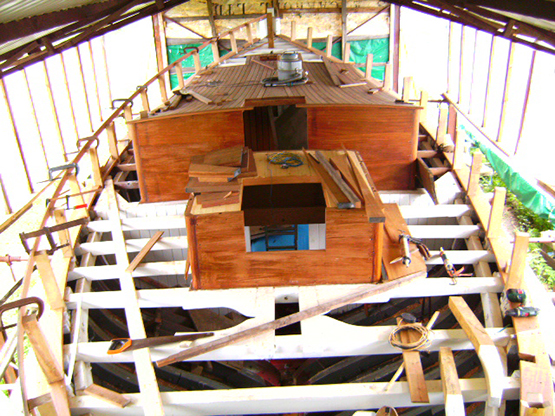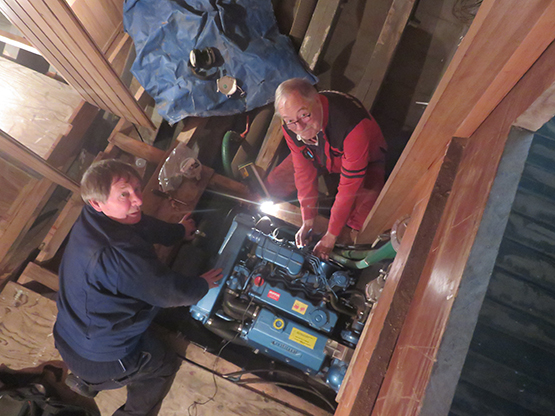Displaying items by tag: Gary McMahon
Christmas Dreams Of Irish Wooden Boats – Old & New, Real & Fantasy
The season is upon us for goodwill and dreams of very special gifts. And for many Irish sailors, the dream Christmas present would be an elegantly classic or solidly traditional wooden boat, with all maintenance and running costs somehow covered by Divine Providence into infinity……W M Nixon goes down the Yuletide timber trail.
Love of wood is part of what we are. It’s in our genes. At some times and some places in the remote past, an instinctive fondness for wood, and an inherited ability to do something useful with it, would make all the difference between survival and extinction. So though today the availability of other more purposeful materials may have transformed boat-building, a new boat without some sort of wood trim is a very rare thing indeed.
At a more personal level, many of today’s generation of sailors cherish family memories of the communal building of wooden DIY kit boats at home. Here, there and everywhere, a drawing room or little-used dining room found itself a useful new purpose as a boat-building salon, with Mirror dinghies and occasionally larger craft taking shape in domestic settings throughout the land.
“Our daddy the boat-builder” became a household name in his own household. And for those who sometimes wonder why today’s adult sailors can become misty-eyed at the very thought of the Mirror dinghy (which really was and is a wonderful design and concept), the answer surely is that at a significant stage of their sailing and family life, a Mirror dinghy was centre stage, the symbol of a family’s shared values, hopes and interests.
But maybe the most important thing about the Mirror is that she is so eminently practical. So perhaps at Christmas we should allow our imaginations to take flight and soar high to envisage the complete wooden dreamship. And there she is as our header image, introducing this week’s meandering thoughts. That schooner at the moment is total fantasy. But any sailing enthusiast who looks at that concept design and doesn’t think: “Now there’s my dreamship”, well, he or she just doesn’t have a true sailing soul.
The origins of Eirinn, as she is named for the time being, go back to 2012, when the nascent Atlantic Youth Trust sought suggestions as to what a new sail training vessel for all Ireland should look like. But with their proposals recently getting the first real hints of a fair wind from both governments, the AYT have gone firmly down the route of a 40 metre steel barquentine.

The Ilen as she was in the Spring of 2015 in Oldcourt...
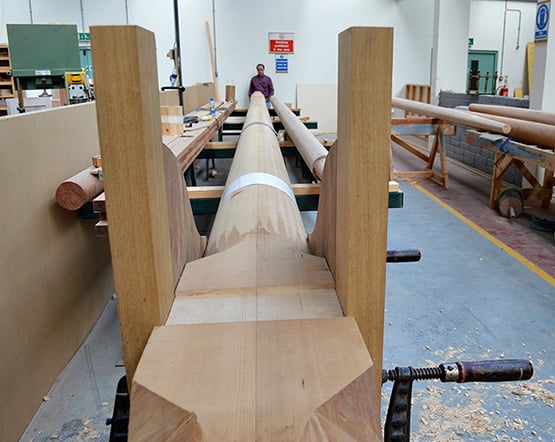 ….while in the Ilen Boatbuilding School in Limerick, spars and deckhouses were taking shape
….while in the Ilen Boatbuilding School in Limerick, spars and deckhouses were taking shape
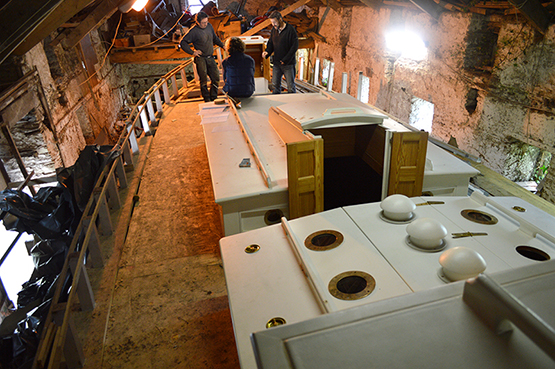
Deckhouses built in Limerick are offered up on the Ilen in Oldcourt
However, down in Limerick where they were busy with moving forward the restoration of the Conor O’Brien 1926 ketch Ilen at two sites – the hull with Liam Hegarty in Oldcourt near Baltimore in West Cork, and the deckhouses, spars and other smaller items being built at the Ilen Boat Building School in Limerick – they gave some thought in 2012 to the possible form of a new sail training vessel. They came up with the concept of a classic 70ft schooner which they knew, thanks to the work on Ilen, that they could build themselves using the skills learned and deployed in re-building the O’Brien ketch.
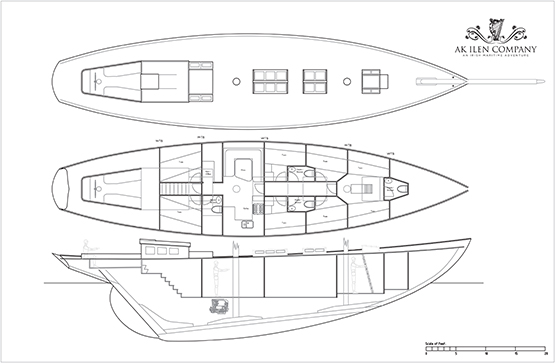
A classic hull for a classic schooner – Theo Rye’s profile and general arrangements plan for the schooner concept of 2012
But with the Ilen project moving steadily on towards the vessel’s commissioning next summer, and with other directly-related new proposals at an advanced stage in the pipeline, that sublime schooner concept is in a sort of limbo, truly a fantasy.
Yet she’s such a lovely thing that we’re happy to use her as our symbol of Christmas cheer. Her creators are Gary MacMahon of the Ilen Boatbuilding School, and Theo Rye, who is best known as a technical consultant in naval architecture, and on clarifying matters of design history and detail in boat and yacht design. But he can turn his hand to all sorts of design commissions if required. He came up with the clever concept for the CityOne dinghies in Limerick, and when Gary started musing about a classic training schooner, within the scope of what the Ilen school could do, as their answer to the AYT sail training vessel query, Theo came up with the goods and then some.
In fact, the design of the hull is so perfect that we’ll run it again right here to save you the trouble of scrolling back to the top. The overhangs at bow and stern are in harmony, but it is the sheerline which is the master-stroke. There isn’t anything you’d want to change in it, yet when you look at other famous schooners such as the fictional Southseaman (in real life she was Northern Light) in Weston Martyr’s masterpiece of maritime literature The Southseaman – the Story of a Schooner (1926), we see a sheerline which is too flat in the way of the foremast. But with Eirinn, the curve is just right, and it’s something achieved by tiny adjustments and balances which the eye can’t really perceive, yet somehow it registers the sublime harmony of the total concept.
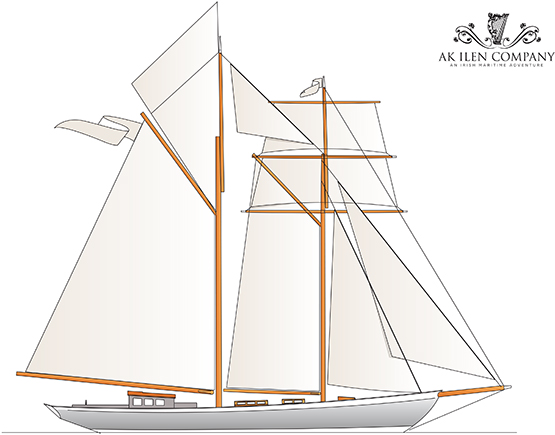
Worth a second look – and then a third one. The longer you look at the lines of Eirinn, the sweeter they seem. But her overall appearance might be improved with a slight rake of the masts
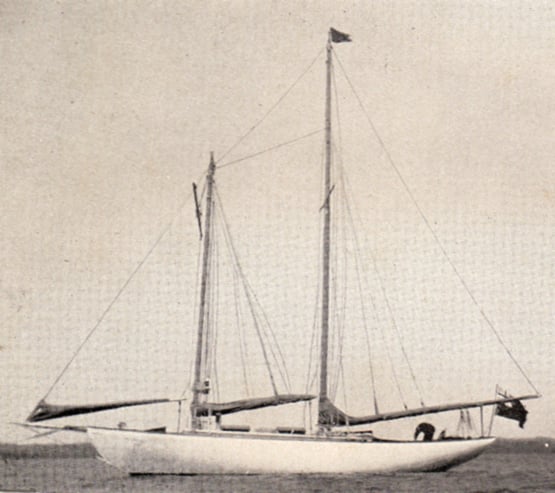 A schooner sheer not quite right – Weston Martyr’s Southseaman (aka Northern Light) could have done with a livelier sheerline abeam of the foremast.
A schooner sheer not quite right – Weston Martyr’s Southseaman (aka Northern Light) could have done with a livelier sheerline abeam of the foremast.
So Theo Rye not only writes critiques of other people’s designs, but if given the chance he can personally come up with something which is wellnigh impossible to fault. Of course, we mightn’t quite go for the same rig – a little bit of rake in the masts wouldn’t go amiss - and for private use you’d want something a little different from the dormitory layout of the training ship. But that said, this is a beautiful yet not excessively pretty-pretty hull, a boat which sings. And the fact that she’s beyond just about every private owner’s reach only adds to the mystique.
But to redress the balance, last week we’d an inspiring evening’s entertainment and information about a dreamship which really is being re-created. It was the December gathering of the Dublin Bay Old Gaffers Association in the ever-hospitable Poolbeg Y & BC, and a full house was there to hear about how Paddy Murphy of Renvyle in the far northwest of Connemara is getting on with his mission of bringing the famous Manx sailing nobby Aigh Vie back to life.
Paddy himself is something special. When asked his trade, he says he’s a blacksmith. But he can turn his hand to anything. Originally a Dub, his early sailing experiences included owning a Flying Fifteen and a Dragon, though not – so far as I know – at the same time. But then got the gaff rig traditional boat bug, and a sail on Mick Hunt’s Manx nobby Vervine Blossom sent him in pursuit of near-sister Aigh Vie. She was reportedly for sale, having for a long time been the pet family cruising boat of Billy Smyth and his family at Whiterock Boatyard on Strangford Lough, after spending her final working years fishing as a motorized vessel out of Ardglass.

Aigh Vie as she was in Whiterock Boatyard when Paddy Murphy bought her, her elegant huul shape clearly in evidence
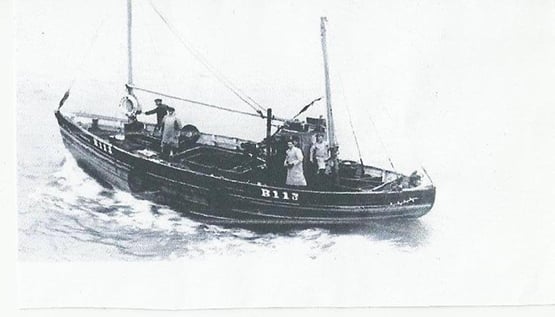 Aigh Vie in her final working days as a motorised fishing boat based at Ardglass
Aigh Vie in her final working days as a motorised fishing boat based at Ardglass
The deal was done, an ideal buy for a special man like Paddy Murphy, for the Aigh Vie is one very special vessel. The Manx fishing nobbies reached their ultimate state of development in the first twenty years of the 20th Century before steam power and then diesel engines took over. The nobby evolved to an almost yacht-like form through vessels like the 43ft White Heather (1904), which is owned and sailed under original-style dipping lug rig by Mike Clark in the Isle of Man, and the 1910 Vervine Blossom, now based in Kinvara, which was restored by Mick Hunt of Howth, but he gave her a more easily-handled gaff ketch rig which looked very well indeed when she sailed in the Vigo to Dublin Tall Ships Race in 1998.
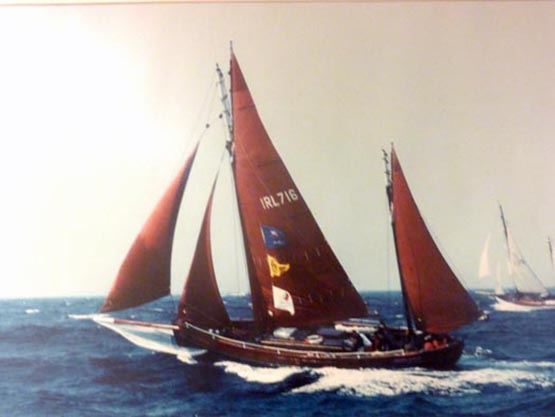
It was a sail on Mick Hunt’s 1910-built Manx nobby Vervine Blossom which inspired Paddy Murphy to go in pursuit of Aigh Vie
It takes quite something to outdo the provenance of these two fine vessels, but the story of Aigh Vie (it means a sort of mix of “good luck” and “fair winds” in Manx) is astonishing. It goes back to the sinking of the Lusitania by a German U Boat off the Cork coast in May 1915, when the first boat to mount a rescue was the Manx fishing ketch Wanderer from Peel, her crew of seven skippered by the 58-year-old William Ball.
They came upon a scene of developing carnage. Yet somehow, the little Wanderer managed to haul aboard and find space for 160 survivors, and provide them with succour and shelter as they made for port. In due course, as the enormity of the incident became clear, the achievement of the Wanderer’s crew was to be recognised with a special medal presentation. And then William Ball, who had been an employee of the Wanderer’s owner, received word that funds had been lodged with a lawyer in Peel on behalf of one of the American survivors he’d rescued. The money was to be used to underwrite the building of his own fishing boat, to be built in Peel to his personal specifications. The name of the donor has never been revealed, but the result was William Ball’s dreamship, the Aigh Vie, launched in December 1916 and first registered for fishing in January 1917.
Over the years, the Aigh Vie became a much-loved feature of the Irish Sea fishing fleet. Tim Magennis, former President of the Dublin Bay Old Gaffers Association, well remembers her from his boyhood days in the fishing port of Ardglass on the County Down coast. Her working days over, Billy Smyth gradually converted her to a Bermudan-rigged cruising ketch with a sheltering wheelhouse which enabled the Smyth family to make some notable cruises whatever the weather. His son Kenny Smyth, who now runs the boatyard with his brothers and is himself an ace helm in the local 29ft River Class, recalls that the seafaring Smyth family thought nothing of taking the Aigh Vie to the Orkneys at a time when the average Strangford Lough cruiser thought Tobermory the limit of reasonable ambitions.
After he’d bought the Aigh Vie and brought to her first base in Howth, Paddy Murphy soon realised he’d still a lot to learn about sailing and about keeping hard-worked old wooden boats in seafaring condition. But he’s such an entertaining and inspirational speaker that you’re swept along in his enthusiasm and empathise with his admission that, now and again, he felt things were getting on top of him.
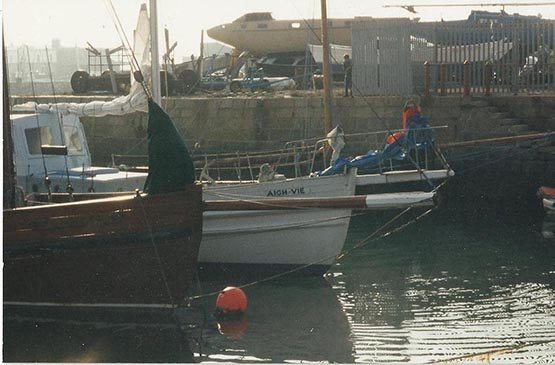
Sisters - Vervine Blossom (foreground) and Aigh Vie in Howth
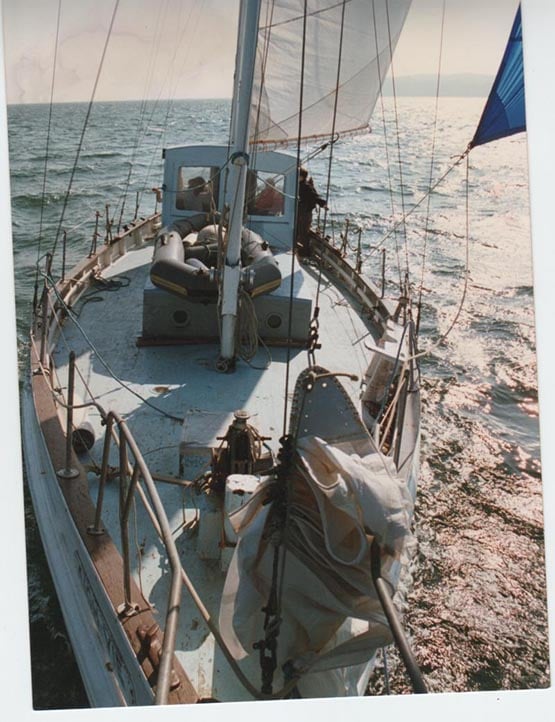
Sailing days on the Aigh Vie from Howth, before it was decided that she needed a major restoration
Following several seasons with increasing evidence of problems, he decided that a virtual re-build was necessary. It was then that the Dublin wooden boat owners’ perennial problem shot to the top of the agenda. In our very expensive city, the space and shelter to work long hours at an old wooden boats is almost impossible to come by, and he’d to shift the big Aigh Vie several times. On one occasion, he was asked to move in a hurry out of an ESB shed, but was offered £1,000 (this was pre-Euro days) to do so. He moved heaven and earth and finally found somewhere else at considerable expense, got the Aigh Vie installed there, and then went back to collect his thousand snots. Only to be laughed at. The manager told him it was the only way he could see to get the old boat moved out, but there were absolutely no funds available at all for such a thing, and surely Paddy would have guessed that?
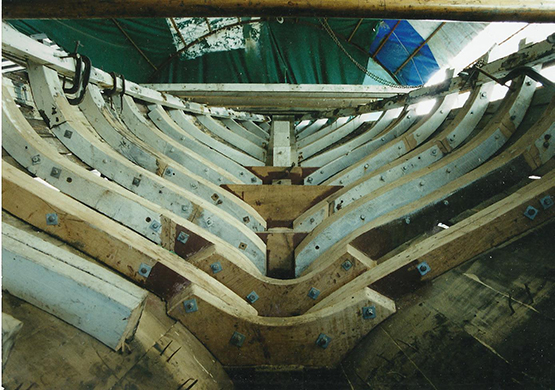
The re-building under way at Renvyle, using the technique where hull shape is retained by first replacing every other frame
With one thing and another, he moved to Renvyle in Connemara where he liked the big country and the open spaces and the friendly people right on the edge of the Atlantic, and in time Aigh Vie came too, and found herself being slowly re-born under a special roof. But it was demanding work for one man, so every so often a team led by Paul Keogh of the famous Galway Hooker from Clondalkin, the Naomh Cronan, together with a good selection of DBOGA specialist talent, descends on Renvyle to put in a ferocious day or two of work, and then on the Saturday night they put a fair bit of business the way of the pub at Tullycross.
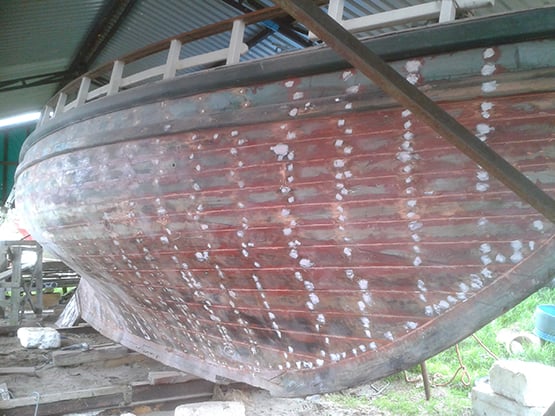
The planking was more easily restored by laying the Aigh Vie over on her side
Agh Vie upright again, and the deckhouses are being put in place
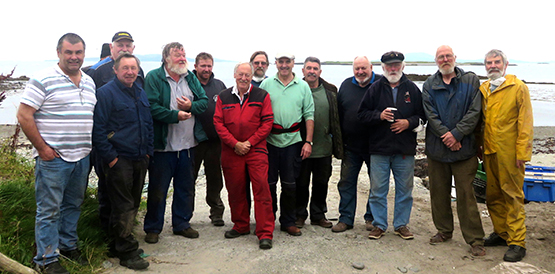
Old Gaffers Association International President Sean Walsh (right) and Peter Redmond install Aigh Vie’s new Perkins diesel. Photo: Cormac Lowth

One of the options for Aig Vie’s rig is the classic lug ketch as shown here with Mike Clark’s 1903-built White Heather
So now, many years later, the journey towards the restored Aigh Vie is getting near its destination. But it will never be fully ended. Thanks to sails, spars and rigs donated from other boats, Paddy has the choice of either gaff ketch or classic lug rig, so she’ll always be work in progress. Which is good news. Because every couple of years or so, the DBOGA can guarantee a full house to hear Paddy Murphy talking about how the Aigh Vie story is going.
He’s a wonderful speaker, sometimes almost messianic, and he shares his every feeling. Thus he mentioned that one day he was feeling a bit low, and he just went out to look at the big boat down by the shore, seeking some sort of inspiration. His mind had been elsewhere with the details of completing the interior, but he suddenly realised that he was at the stage of thinking of putting the white paint on the topsides. So he just set to with a big paint brush and a bigger tin of paint, and Aigh Vie was transformed. So was he. “That’s the secret” says he. “If you’re feeling a bit down, just go out and slap on some white paint. It works wonders.”

Feeling a bit down? Then just go out and slap a coat of white paint on the boat – it works wonders
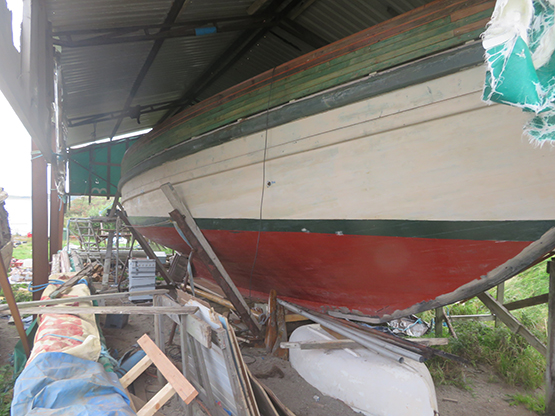
Limerick 'CityOne' Sailing Dinghies Unite The Shannonside Capital As One City
Minister for Finance Michael Noonan, the senior TD in Limerick, yesterday morning launched a "Naumachia in the Cathedral" with the boats built in the visionary CityOne project in the Shannonside city. On Monday afternoon, President Michael D Higgins will also see the boats in St Mary's Cathedral, and meet those involved. It has all become a key part of the Limerick City of Culture 2014, but as W M Nixon reveals, the success of the CityOne dinghies is just part of a remarkable continuing series of creative boatbuilding programmes.
Gary MacMahon of Limerick has a remarkable talent for publicity. Yet he doesn't court it personally. On the contrary, he tends to keep to one side when events he has brought about are in full swing. But because he keeps coming up with visionary ideas which no-one else had thought of before, and also has the ability, patience and quietly persuasive powers to bring them to fruition in the fullness of what is sometimes a very long time, inevitably the novel brilliance of what he has achieved hits the attention button big time.
By profession, he is a graphic and website designer running Copper Reed Studios in Limerick city with his wife Michelle and a staff of six. But like all Limerick people, he has a passion for seeing his home town doing better, improving its image, and making itself a more enjoyable place. And when that passion is allied to the MacMahon powers of vision and dreaming the dream, the results can be extraordinary.
He first came to national attention within Ireland's maritime community back in 1998, when he inspired and organized the return of Conor O'Brien's ketch Ilen from the Falkland Islands. In 1923-25, the magnificent voyage by Conor O'Brien of Foynes on the Shannon Estuary round the world in the 42ft ketch Saoirse – which he'd designed himself to be built in Baltimore – had in turn resulted the Falkland Islanders being so impressed by Saoirse when she sailed in to their lonely archipelago after rounding Cape Horn, that they ordered a larger sister sister-ship to be built for their inter-island service vessel.
This resulted in the cargo and passenger carrying 56ft ketch Ilen, designed by O'Brien (an architect by training though a writer by vocation)) and Tom Moynihan, who'd built Saoirse and now built the new vessel in Baltimore in 1926. The ketch finished, the difficulty was getting her to her new owners in the Falklands. In the end, to get insurance for the delivery trip in which he would be in command, O'Brien had to register the Ilen as a yacht, and he sailed her out to the Falklands as he'd sailed Saoirse, under the burgee of the Royal Irish Yacht Club, with Ilen crewed by two islanders from Cape Clear.
Meanwhile Saoirse, having gone through a few mostly happy ownerships, was wrecked after being driven from her moorings in a hurricane in Jamaica in 1979. The gallant Ilen, still working away in the Falklands and now fitted with a larger auxiliary engine, continued to give good service. But by the 1990s the word was that she was no longer in use, having been laid up on moorings at Port Stanley, reportedly in basically quite good order but inevitably suffering from the region's severe weather.
Ilen was now unique as the only surviving O'Brien seagoing design. So one crisp morning in the winter of 1997-98, Gary MacMahon suddenly found himself possessed by the notion that the Ilen should be brought back to Limerick just as soon as possible to act as a re-birth symbol for the revitalization of a riverine city and its mighty Shannon Estuary, all of which were going through turmoil with industrial decline and the moving of Limerick port's operations downstream to Foynes and other deep-water pier locations.

The Conor O'Brien-designed, Baltimore-built 56ft ketch Ilen back in Irish waters in 1998 for the first time since 1927. She is seen here in Dublin Bay before being sailed to Oldcourt on the Ilen River in West Cork. Photo: W M Nixon
Quite how he managed it all we can only guess, but within what seemed like a matter of days he found himself in Port Stanley with the deal done to buy the Ilen, and in the early Spring of 1998 she was unloaded from a ship in Dublin docks. Now what? Clearly, the old ketch needed massive restoration work in order to make her fit for any regular seagoing service under sail with trainees or passengers on board. But with her size and the special demands of her age and construction, there was only one place in Ireland where the work could be confidently undertaken, the Hegarty boatyard at Oldcourt on the River Ilen in West Cork just a few miles upstream from Baltimore where the ketch had been built 72 years earlier.
So in the summer of 1998 she was commissioned in Dublin Bay, and sailed under the command of Paddy Barry to Baltimore and a rapturous welcome. Then in time she was hauled into and old stone waterfront shed in Oldcourt, and here she has been ever since while a continuing programme of restoration has become, as is so often the case with old well-used boats, a virtual re-build, but done in such a way that the shape of the original vessel is exactly replicated, and at any time in going into the shed you are in fact looking at the Ilen.
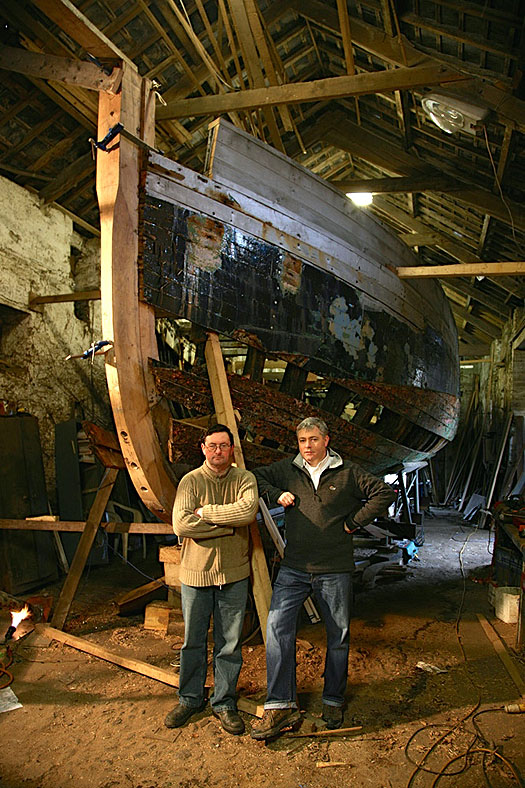
Work in progress – and it's still in progress. Boatbuilder Liam Hegarty (left) and Gary MacMahon at an early stage of the Ilen restoration, when the stem had been replaced.

Replacing frames in Ilen at Oldcourt. Once the frames are all located, planks can also be replaced where necessary without any loss of the vessel's shape.
To do this, trainee boat-building schemes were implemented, with a strong Limerick emphasis in the recruiting. It soon acquired an international element with an input from many renowned traditional boatbuilders, until five years ago it was given a more formal structure with the establishment of the AK Ilen Boatbuilding School. The work continued in Oldcourt, but they also had bright new premises in Limerick where deckhouses and so forth for the Ilen could be built. But it was very quickly realized that a building programme for smaller boats in the Limerick premises would also provide a rewarding interest for people from all sorts of backgrounds who could find fulfillment – often unexpected fulfillment and mental serenity – in working with wood and building boats.
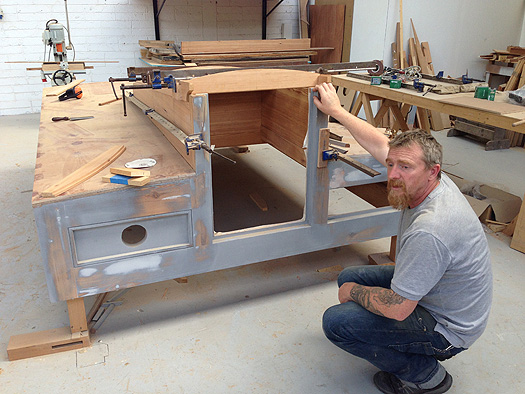
Ship's carpenter JimMcInerney with the new deckhouse for Ilen in the boat-building school's Limerick premises
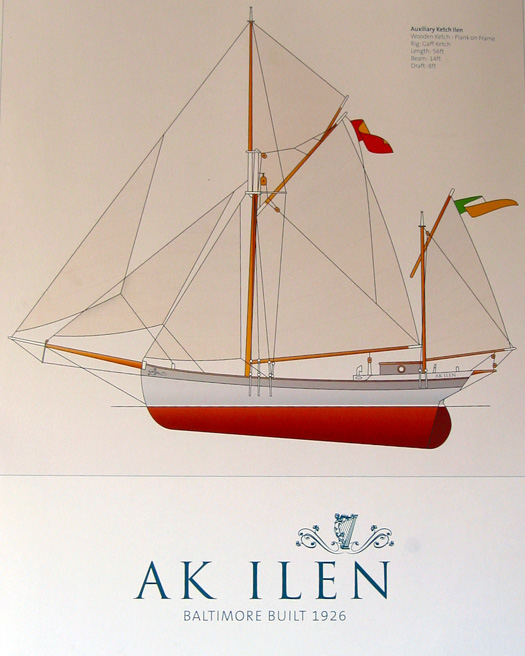
The objective – Ilen as she will look when restored. Her underwater profile was shaped to facilitate landing people and goods at drying quays, or even directly onto a beach.
Initially they used a simple dory design, but then came a typical MacMahon stroke of genius. There's a type of boat unique to the Shannon Estuary known as the gandelow. The classic gandelow is around 23ft long, and while above the water she may look like a hefty version of a typical Irish clinker-built lakeboat as beloved by the mayfly fishermen, underneath she is completely flat-bottomed in order to have minimum draft, and to be capable of slithering across the gooey mud with which the 60-mile long Shannon Estuary, with its 5 metre tidal range, is generously provided.

New gandelows a-building. The project eventually fused into the programme for Limerick City of Culture 2014
Quite how the name "gandelow" emerged back in the mists of time from a mangling of the Venetian word "gondola", if indeed it did, is anyone's guess. But the old boats are still actively used – a good place to see them is just below the bridge at Bunratty. However, with the encroachment of glassfibre workboats and robust aluminium knockabouts, it was at least thirty years since a new gandelow had been built in traditional style. But when Gary MacMahon and his team had their lightbulb moment to build a flotilla of 23ft gandelows in the Ilen base in Limerick, everything began to come much more strongly to life, and the Gandelow Gang was born.
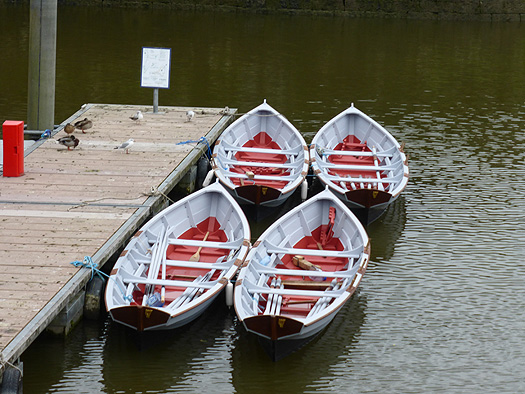
The elegant drawn-out transom of a gandelow.......Photo: W M Nixon
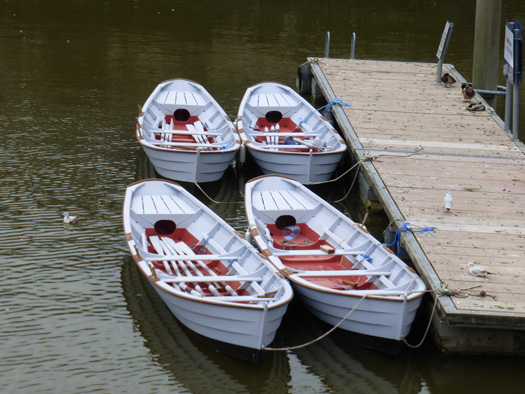
...contrasts markedly with the no-nonsense shape of the bow. Photo: W M Nixon
The real secret of the success of such a project is that once the boats are built, they must as more than interesting maritime objects. They have to be used, and used as much as possible, taken to different venues and rowed in active competition both for team building and the sheer sport of it all. The classic gandelow is rewarding to row. She's hefty enough, but with proper teamwork quite a respectable speed is possible, and the sport is good but as with any boat racing, skilled mark-rounding can be crucial to success, particularly so with these flat bottomed skid-pans which can slide sideways when you're trying to cut through on the inside curve.
As for locations, in 2014 alone the Gandelow Gang have been making the scene at the Battle of Clontarf re-enactment in April (after all, the original winner Brian Boru was a Limerick man, even if he was killed at the end of it). Then in late April they were in Venice. Just like that. For where else in Europe would you feel obliged to take a gandelow?

Getting afloat in Venice, Limerick style. The Gandelow gang had to make their own launching arrangements when they arrived in the Serenissima.....
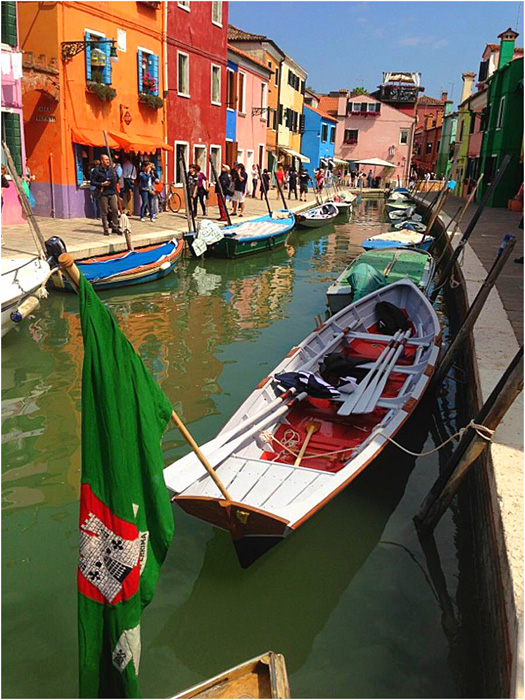
.....but once established in Venice, they were soon part of the scene
When Limerick folk decide to up and go from their homely city, they get on and do it, and though they were co-ordinating with the Serenissima's Master of Waterborne Ceremonies in Venice, they did many things their own no-nonsense way. And as for how a squad of ordinary Limerick people can afford a six-day stay in one of the most expensive cities in the world, the word is they sussed out a convent right at the heart of things where deserving guests can stay for €25 per night.

The Baltimore Wooden Boat Festival in May provided another showcase for the gandelows. Seen here rowing their classic Limerick boat towards the gaff ketch Sile a Do are Liam O'Donoghue, Anthony Kenny and Robert Smalle
For the gandelows back from Venice, in addition to races at home, 2014 continued with the Baltimore Wooden Boat festival at the end of May, the Lough Scur Midsummer Festival in June, and the Ballydehob Gathering of the Boats in August (see this blog September 6th). This would be enough for most of us to be getting along with, but back in the Ilen base in Limerick another project was rapidly taking shape, the CityOne sailing dinghies.
Inner city interest in small boats in Limerick had been aroused by the gandelows, so the building of a class of sailing dinghies was seen as adding a logical new element. But while some people thought something like a GP 14 or the heftier Wayfarer might best fill the bill, this was to miss the point of the Ilen experience entirely. To work, the boats had to be built in Limerick in the first place, and be to a unique design.
If this sounds a bit crazy, look at it as the small boat version of craft beers. Just about every town and village in Ireland now has its own craft brewery, and they cater for a thriving home and export trade for public tastes jaded by standardization and centralization. The making of the beers is as much part of the interest as their tasting and consumption. Equally so is the Ilen School philosophy for boats. The new CityOne dinghies were to be built from scratch, and their team-led construction, by people from every walk of life who had found a worthwhile interest in building small boats, would be vital to the success of the project.

Gary MacMahon (left) with Theo Rye, designer of the CityOne. Photo: W M Nixon
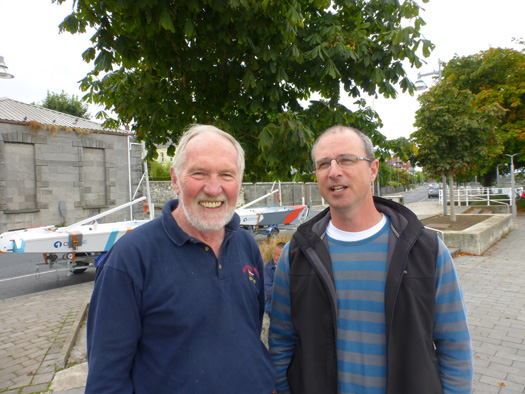
Hal Sisk (left) assembled a team to publish the G L Watson book, and from that Theo Rye (right) became the designer of the CityOne. Photo: W M Nixon
Everything hung on finding the right design. But with typical MacMahon serendipity, the right man was brought in. Gary had been much involved in his work as a designer with Hals Sisk's Peggy Bawn Press in creating that masterful and massive volume, the copiously-illustrated "G L Watson, the Art & Science of Yacht Design" by Martin Black, a wonderful account of the story of the great Scottish yacht designer which has deservedly won international awards since its publication in 2011. And among the team of all the talents involved in its creation was naval architecture historian and innovative boat designer Theo Rye, who was soon absorbed by the challenge of creating a design for a sailing dinghy which would be rewarding to sail, yet could be built in Limerick in timber – mostly plywood – by enthusiasts many of whom had little or no skill in boatbuilding, or even elementary woodwork.
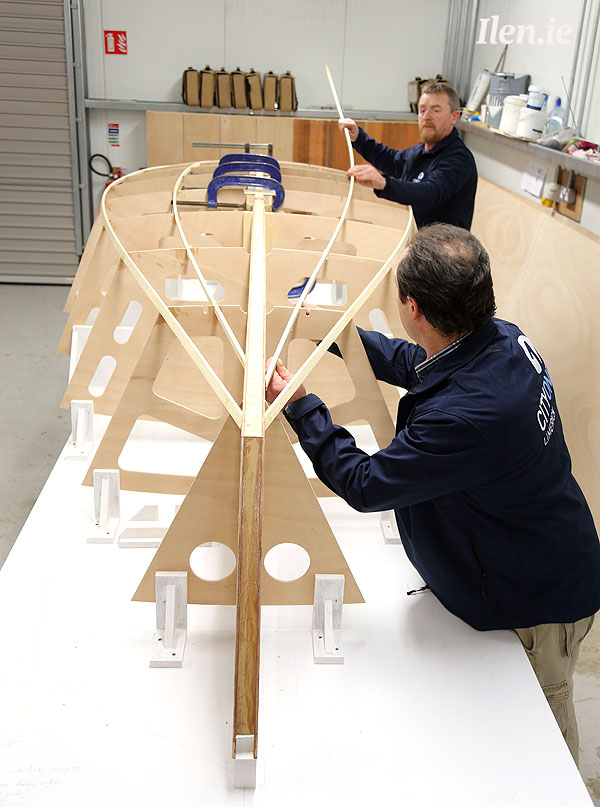
Early building stage of the first CityOne
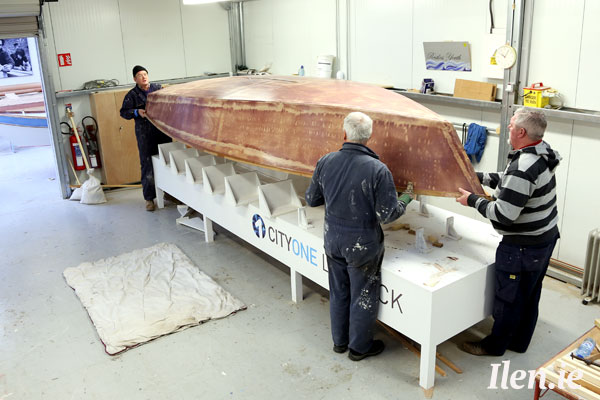
The basic hull is lifted clear........

....and the attractive wood engineering of the interior is completed.
The result is a basically simple flat-bottomed design but with some beautiful wood engineering, as you'd expect with Hal Sisk donning his other hat as an engineer to make input into the construction details. Yet overall the concept is one of attractive simplicity. To move on from this, the Ilen group organized an international graphic design competition for ideas for the colour schemes for the first four boats. They attracted 61 entries worldwide, and the four selected schemes were from Cale Funderburk of Texas, Andre Aguiar of Portugal, Kashyap Gohel of Kenya, and Con Ryan of Limerick.
We've had teaser photos on Afloat.ie in recent weeks showing the first of these hyper-colourful boats having their trial sails, but believe me folks, you ain't seen nothing until you've seen them all together, and that only became possible last Saturday morning as the last of the foursome had only had her final coat of paint on Friday night.
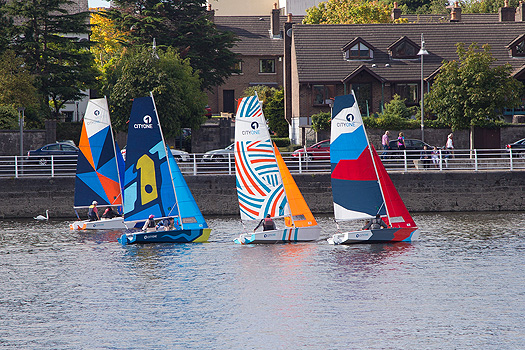
The first four CityOne dinghies racing together on the Shannon in the heart of Limerick on Saturday September 20th 2014 are decorated in the colour schemes created by (left to right) Con Ryan (Ireland), Kashyap Gohel (Kenya), Andre Aguiar (Portugal) and Cale Funderburk (Texas).
It was just in time, and what a time we had down on Shannonside in Limerick last Saturday, with the CityOne flotilla making their debut in the heart of town in a series of races masterminded by Geoff O'Donoghue of Lough Derg YC, while the gandelows staged a regatta in tandem with the sailing with some mighty oarsmanship.
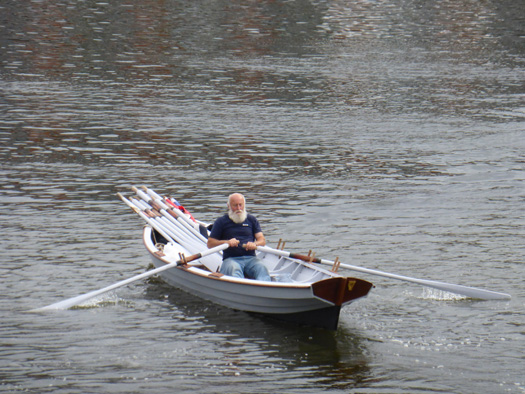
Off to the races. Gandelow stalwart Liam O'Donoghue rows across the river with oars and pennants ready to race. Photo: W M Nixon

Geoff O'Donoghue of Lough Derg YC calls the first start of the gandelow races, which got off to a slightly ragged beginning.......Photo: W M Nixon
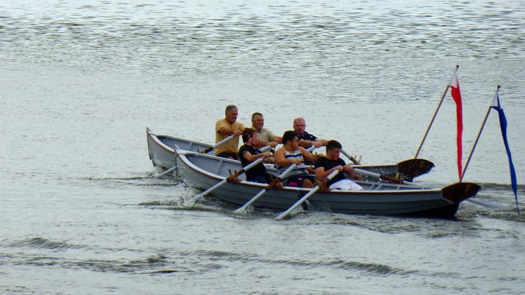
......but soon the crews were settling into their stride......Photo: W M Nixon

.......and by the finishes, the winning crews were setting a ferocious pace. Photo: W M Nixon
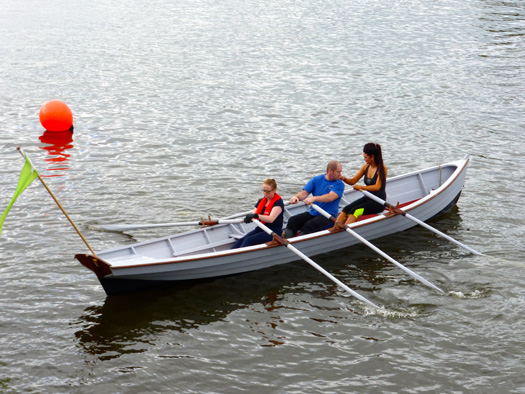
The Ladies Crews were allowed one man on board....Photo: W M Nixon

....but when it came to the racing, they were equally determined. Photo: W M Nixon
The sailing and rowing images which have resulted project a Limerick many people won't recognize from popular perceptions of that once-gritty town, but Limerick in its year as City of Culture is being re-born at astonishing speed. Thus the comfortable suburbs along the west side of the river provided an affluent, well-established and leafy background, but across on the east side, right in the heart of the old city's waterfront, the re-born Howley's Quay, with rugby legend Peter "The Claw" Clohessy's pub at the centre of it, provided an ideal regatta headquarters.
Pride of place in the Clohessy super-pub establishment is a completely re-vamped fine dining venue. As Gary MacMahon happened to be the design consultant on that, he persuaded the boss that it should be re-named The Gandelow Restaurant. So with the gandelows effecting their crew changes at the steps inside the new boardway right at the pub, all our ducks – and swans too – were neatly in a row to get a photo of a gandelow at The Gandelow.
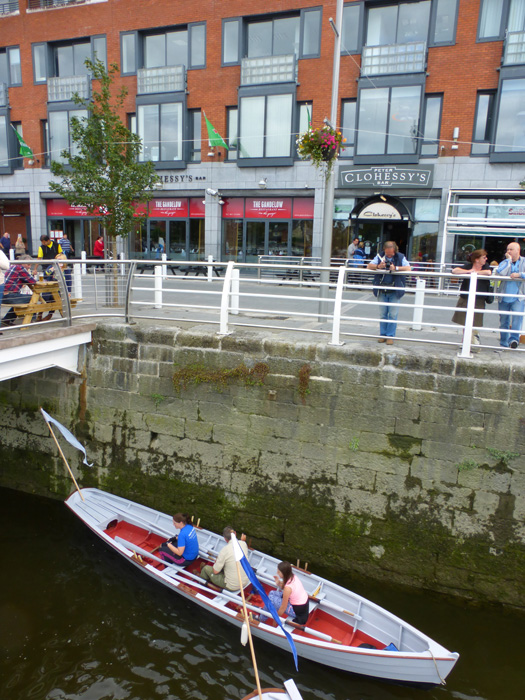
Peter Clohessy's famous bar-restaurant on Howley's Quay in Limerick provided an ideal regatta base......Photo: W M Nixon
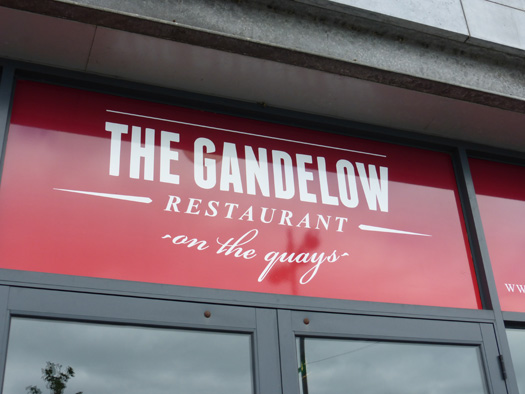
....and he in turn has re-named his fine dining venue in honour of the local traditional boats. Photo: W M Nixon
As to the CityOne racing, it was basically between teams from Culaun SC in Clare, Lough Derg YC, NUI Galway SC, two teams from Garrykennedy SC, Foynes YC, Killaloe SC, and the "Constructors Sailing Club" team which included Gary MacMahon, Theo Rye, Hal Sisk, and Steve Morris the talented New Zealand shipwright who led the building of the superb Sally O'Keeffe down in Kilrush (see this blog on May 10th), and whose guidance in the CityOne project was invaluable.
Many others were involved as RIBS were on hand to bring about crew changes and get as many people as possible, experienced and newcomers alike, out sailing in these remarkable little boats. But in the end, after working out a formula which only he fully understood, Geoff O'Donoghue declared that the winners were NUI Galway led by Cian Walsh.
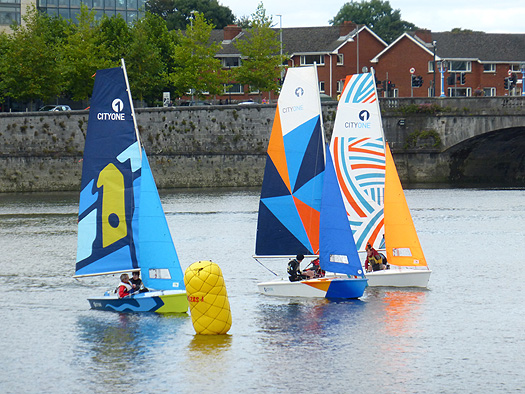
A dream comes true. New boats of the CityOne class sailing together in the heart of Limerick. Photo:W M Nixon

The Shannon in Limerick becomes busy towards high water. Two new boats of the CityOne class are in pre-start manouevres while crews are conveyed to other boats by RIB, and at the west bank a four-oared racing shell from St Michael's Rowing Club finds a clear passage upriver. Photo: W M Nixon
However, the complexity of the racing formula tested even the commentary skills of another of the Ilen team, Brother Anthony from Glenstal Abbey. But his real strength being words which emerge from a quiet study, his thoughts came clearly forefront yesterday, as it was he who thought of calling the current display of the CityOne boats in St Mary's the "Naumachia in the Cathedral".
In this blog in times past, we've outlined the difficulties of making sailing a spectator sport by referring to the experiences of Roman Emperors who occasionally flooded the Colosseum to stage naval battle re-enactments, but even they found these bloodthirsty shows prohibitively expensive. However, thanks to Brother Anthony's research we find that the ancient Greeks were there first, as they coined the phrase Naumachia to capture the flavour of an enclosed naval engagement in a stadium setting. Now, down in Limerick, they've revived it, but with entirely peaceful connotations for boats on harmonious display in a cathedral.
That said, there was once something of a battle in St Mary's Cathedral, and it brings our story full circle by noting that it involved Conor O'Brien of Saoirse fame. Though he didn't practice very much as an architect, one job he took on shortly before leaving on the great voyage of the Saoirse was the design of a screen for St Mary's commissioned by the Glentworth family.
It had been mostly completed in the workshop before he departed in June 1923, but it wasn't installed until he was thousands of miles away in the midst of his voyage. They managed to put it in back-to-front. And it was only O'Brien himself who noticed his on his return. He was a man with a notoriously short fuse. It boggles the mind to imagine the scene.
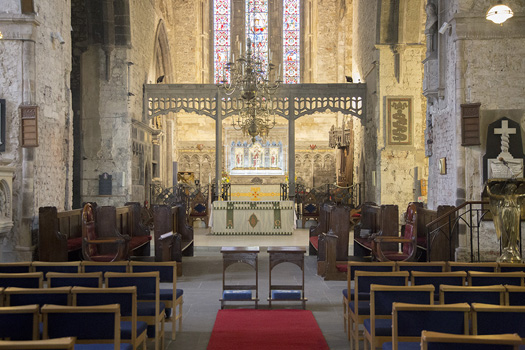
The Glentworth Screen in St Mary's Cathedral in Limerick was originally installed back-to-front while its architect Conor O'Brien was away on his famous voyage around the world in Saoirse..
But now, with the Glentworth Screen the right way round, all is sweetness and light in St Mary's Cathedral for the boats of the Ilen school. Michael Noonan TD launched the exhibition yesterday. President Michael D Higgins will be there on Monday afternoon. And as the boats are in the Cathedral for another two weeks , it's well worth seeing for a project which has helped to give unexpected added meaning to Limerick's role as City of Culture.
For as Minister Noonan put it at his launching of the exhibition: "I have always had the notion that the divisions between art and craft were too separate in Ireland, and that not enough credit was given to people that can do things with their hands, and are truly expert in their craft. There is a much wider concept where the artists and craftsmen come together and you get an integrated culture, and we can all celebrate that coming together here today".

Sea and city intertwine. The new boardwalk bridge at the Howley's Quay Steps was ideal as a viewing platform, while the steps greatly aided crew changes for the gandelows. Photo: W M Nixon
Limerick to Host New Boatbuilding Degree Courses
A new scheme to teach traditional boatbuilding skills to university level could be of huge benefit to young people from disadvantaged areas of Limerick.
The Irish Times reports that degree programmes in traditional boat craft accredited by the UK's University of Middlesex are set to take their first students in 2012.
Minister for the Marine Simon Coveney also confirmed that partnerships have been developed with the US Northwest School of Wooden Boat-building and Sail Training International.
Some 40 trainees, mostly from Limerick's designated regeneration areas, have already taken part in the restoration of the ketch Ilen, designed by record-breaking sailor Conor O'Brien.
The AKA Ilen project, set up by boat-builder Gary McMahon, is intended to "nurture self-belief and confidence through the medium of wooden boatbuilding and maritime education".
The Irish Times has more on the story HERE.



























